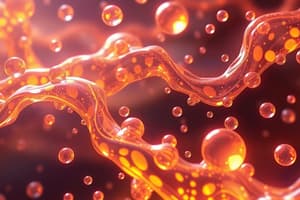Podcast
Questions and Answers
What is the energy difference between lipids and carbohydrates/proteins?
What is the energy difference between lipids and carbohydrates/proteins?
Two and a half times more energy than carbohydrates and proteins
What are lipids characterized by?
What are lipids characterized by?
Greasy feel, insolubility in water, and solubility in some organic solvent
At what temperature are fats solid?
At what temperature are fats solid?
20°C
What are simple lipids made up of?
What are simple lipids made up of?
Give an example of compound lipids.
Give an example of compound lipids.
What are sterols made up of?
What are sterols made up of?
What is the composition of fats?
What is the composition of fats?
How are fatty acids structured?
How are fatty acids structured?
What is the recommended fat intake for a 2000 Cal diet?
What is the recommended fat intake for a 2000 Cal diet?
What are the consequences of excessive fat intake?
What are the consequences of excessive fat intake?
What is the energy yield per gram of fat?
What is the energy yield per gram of fat?
What is the energy yield per gram of carbohydrate or protein?
What is the energy yield per gram of carbohydrate or protein?
What is the function of fat in the body?
What is the function of fat in the body?
What are the two types of fatty acids based on their saturation?
What are the two types of fatty acids based on their saturation?
Where are saturated fatty acids found?
Where are saturated fatty acids found?
What is the structure of a triglyceride?
What is the structure of a triglyceride?
Flashcards are hidden until you start studying
Study Notes
Lipids
- Lipids have a higher energy density compared to carbohydrates and proteins.
Characteristics of Lipids
- Lipids are characterized by being insoluble in water and soluble in organic solvents.
Physical Properties of Fats
- Fats are solid at room temperature (normally below 20°C).
Simple Lipids
- Simple lipids are composed of glycerol and fatty acids.
- Example: Triglycerides (triacylglycerols).
Compound Lipids
- Example: Phospholipids.
- Phospholipids are composed of glycerol, fatty acids, and a phosphate group.
Sterols
- Sterols are composed of a steroid nucleus with one or more hydroxyl groups.
- Example: Cholesterol.
Composition of Fats
- Fats are composed of glycerol and three fatty acids.
Structure of Fatty Acids
- Fatty acids have a hydrocarbon chain with a carboxyl group at one end.
Recommended Fat Intake
- The recommended fat intake for a 2000 Cal diet is 65-70 grams per day.
Consequences of Excessive Fat Intake
- Excessive fat intake leads to obesity, cardiovascular disease, and other health problems.
Energy Yield of Macronutrients
- The energy yield per gram of fat is 9 kcal (38 kJ).
- The energy yield per gram of carbohydrate or protein is 4 kcal (17 kJ).
Function of Fat in the Body
- Fat serves as energy storage, insulation, and hormone regulation.
Types of Fatty Acids
- There are two types of fatty acids: saturated and unsaturated fatty acids.
- Saturated fatty acids are typically found in animal products and some plant-based sources.
Structure of Triglycerides
- Triglycerides consist of glycerol and three fatty acids, forming an ester bond.
Studying That Suits You
Use AI to generate personalized quizzes and flashcards to suit your learning preferences.




